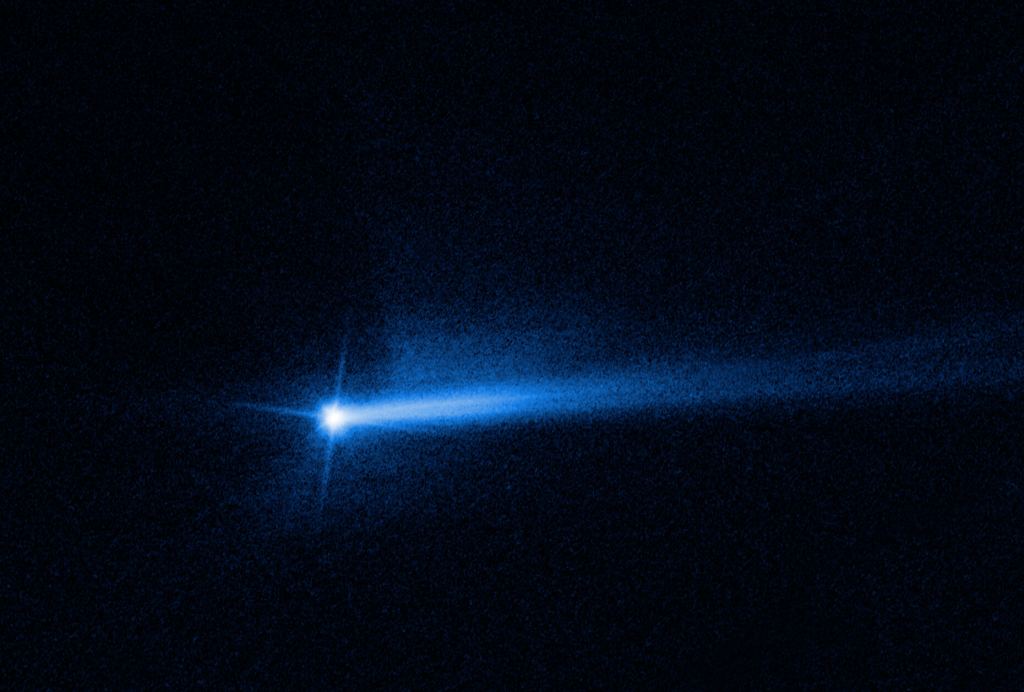On September 26th, NASA’s Double Asteroid Redirection Test (DART) spacecraft collided with Dimorphos, the small moonlet that orbits the larger Near-Earth Asteroid (NEA) Didymos. The purpose was to test a planetary defense technique known as the kinetic impact method, where a spacecraft intentionally collides with a Potentially Hazardous Asteroid (PHAs) to alter its course. Based on a post-collision analysis, NASA determined that DART’s impact altered Dimorphos’ orbital period by 33 minutes and caused tons of rock to be ejected from its surface.
Since the collision, NASA has also been monitoring the cloud of ejecta produced by the impact to see how it has since evolved. The purpose of this is to better understand what the DART spacecraft achieved at the impact site, how much of it was delivered by the spacecraft, and how much was due to the recoil produced by the ejection. On December 15th, during the Fall Meeting of the American Geophysical Union (AGU) in Chicago, members of the DART team provided the preliminary analysis of their findings.
Artist’s impression of the DART mission impacting the moonlet Dimorphos. Credit: ESA Tom Statler, the program scientist for DART, was one of the presenters at the briefing. As he related in a recent NASA press statement: “What we can learn from the DART mission is all part of a NASA’s overarching work to understand asteroids and other small bodies in our Solar System.
Impacting the asteroid was just the start. Now we use the observations to study what these bodies are made of and how they were formed – as well as how to defend our planet should there ever be an asteroid headed our way. ” The team’s report consists of a detailed analysis of all the science and engineering data that focused on measuring the momentum transfer imparted by the DART spacecraft – which was traveling at roughly 22,530 km/h (14,000 mph) when it struck.
Being able to predict momentum transfer accurately is vital to planning future kinetic impact missions in the event that an asteroid is likely to impact Earth. This includes determining the impactor’s size and estimating the lead time needed to push an asteroid off its path. Based on observations before and after, the team learned that Dimorphos and Didymos have very similar compositions.
Both are composed of chondrite, rocky material that formed from dust and small grains in the early Solar System, the same material found in the most common type of meteorite to impact Earth. These measurements also incorporated telescope images of the ejecta, which accounted for the majority of reflected sunlight by the double-asteroid in the days following the impact. These showed how solar radiation pressure stretched the ejecta stream into a twin tail (similar to what comets form) that measures about 10,000 km (6,200 mi).
The last complete image of asteroid moonlet Dimorphos, taken by the DRACO imager on NASA’s DART mission 2 seconds before impact. Credits: NASA/Johns Hopkins APL Scientists also estimate that DART’s impact displaced over a thousand metric tons (two million lbs) of chondrite rock into space – about the same weight as a cargo ship. This data was combined with new information on the moonlet’s composition and the ejecta’s characteristics.
They also consulted telescope observations and images taken by DART’s ride-along CubeSat companion – the Light Italian CubseSat Imaging of Asteroids (LICIACube) – contributed by the Italian Space Agency (ASI). Based on all this data and assuming that Didymos and Dimorphos have the same densities, the team calculated the momentum transferred by the DART impact compared to the recoil generated by the ejected mass. Ultimately, they found that the total energy of the impact and ejecta was roughly 3.
6 times greater than if the asteroid had absorbed the spacecraft and produced no ejecta at all. As Andy Cheng, the DART investigation team lead from Johns Hopkins Applied Physics Laboratory (JHUAPL), explained: “Momentum transfer is one of the most important things we can measure, because it is information we would need to develop an impactor mission to divert a threatening asteroid. Understanding how a spacecraft impact will change an asteroid’s momentum is key to designing a mitigation strategy for a planetary defense scenario.
” The DART test proved that the kinetic impact technique has the potential to divert an asteroid on approach to Earth. The task now is to apply this knowledge so that future asteroid defense spacecraft can be built and the technique tested further. The success of these tests could mean the difference between the continued safety of all life on Earth (and our civilization) and a massive impact that causes mass extinction someday.
Further Reading: NASA The post What Kind of an Impact did DART Have on Dimorphos? The Science Results are Here appeared first on Universe Today. .
From: universetoday
URL: https://www.universetoday.com/159314/what-kind-of-an-impact-did-dart-have-on-dimorphos-the-science-results-are-here/



